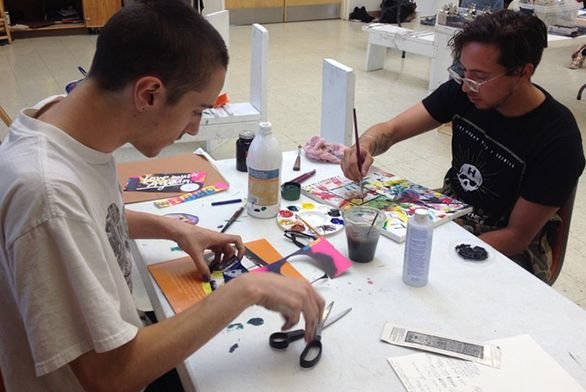Santa Fe Johnnies Flex Their Creative Muscles at Fine Arts Study Group
December 29, 2018 | By Eve Tolpa

Open studio was back in swing this past semester for the St. John’s College Santa Fe campus’s Visual Arts Study Group, and Johnnies were all too happy to take a break from cerebral pursuits and flex their creative muscles.
On one given Sunday, multimedia artist Cole Garibaldi (SF22) cuts up small pieces of colorful paper and arranges them into a geometric composition, while Salomon Cordova (SF21) dabs a fine-point paintbrush across a canvas.
For Cordova, the studio session represents an “opportunity to get away from some other more mentally active aspects of the school.”
Fellow artist Timothy Sykes (SF21) calls it “a lovely outlet for how overworked I usually am.”
Open studio sessions have been a regular feature of Santa Fe campus life since Rebecca Sprague (SF19) started the Visual Arts Study Group in the fall of her sophomore year. Scheduled for every other Sunday from 1:30 to 3:30 p.m. in the second-floor studio of the Fine Arts Building, they are open to students, faculty, and staff, with no RSVP necessary—and attendees are free to drop in and out during the session.
Though this year’s inaugural event offered attendees free rein regarding choice of medium and subject matter, the group meeting usually consists of a two-hour figure drawing session. Polity funding is used to hire nude models from the Santa Fe art community and to provide the study group with art supplies: 18 x 24 newsprint paper, charcoal, and grease pencils.
“Of course,” says Sprague, “people are welcome to bring whatever material they are most comfortable with.”
She leads the drawing sessions using what she calls “the Johnnie approach,” with “no real instruction or assignments, just facing the subject and the materials on their own terms and being aware of what we as artists bring to them. The process is open-ended. I tell people to use as much paper as they can and not to be afraid of messing it up.”
She sees visual arts as essential to liberal arts, and for a while the study group alternated figure drawing with Art Seminar, where students took turns presenting a work of art and a very short related text, talking about both for an hour.
“[It gave] people a place to explore what role art has in the curriculum,” Sprague says. “I’d love to start it up again.”
She’s thought a lot about her own experience of the relationship between art and academics—and how it led her to a new and unexpected perspective on mathematics, historically one of her most challenging subjects.
“Math, like visual art, requires practice to develop an intuition of the medium,” she says. “The difference is that math has a reputation for being highly rigid and scientific, when in reality it has a similar creative malleability to paint. Something that really drove this home for me was my junior lab tutor, Mr. Wales, telling our class that we have to ‘trust the algebra’ and that ‘formulas store information in their symbols.’ If math needs trust or belief, then it is dictated by a similar subjectivity which is stereotypically associated with areas of study such as art or religion.”
Sprague also finds that an artistic practice cultivates transferable skills. “You gain confidence. That can be instilled in something as basic as a two-hour figure drawing session.”
Sykes agrees and takes it a step further: “It builds a sense of perceptiveness. It helps develop the eye. I can look at a material thing with no less scrutiny than I would a book.”
“I think just getting people seeing is the most important part,” Sprague says, summing up the focus in a quintessential St. John’s fashion: “It’s a reading.”

